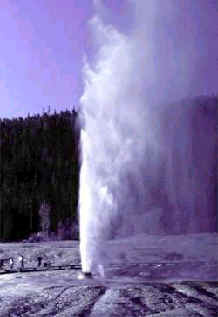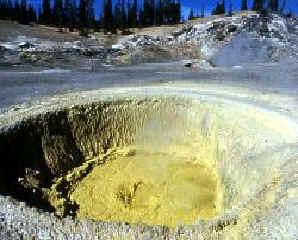 |
| Yellowstone geyser |
At one time the Corps of Topographical Engineers employed a rude, brawling bunch of men who wouldn't know how to fill out a job application if they saw one. They drank a strange concoction of Missouri Valley whiskey (reputedly seasoned with various blends of red pepper, snake heads, and chewing tobacco); bore the marks of Sioux arrows on their arms; and spent the winters in the frigid northern Rockies.
Although such a group might not fit in with today's society, these men were extremely important in the expansion of the Republic. Among them was Kit Carson who was aboard a Missouri River steamer wondering where to go when Lieutenant John C. Fremont offered him a job guiding an expedition to California. Another was Thomas Fitzpatrick, or "Broken Hand," the white-haired dean of the mountain men and guide to several Engineer expeditions. Jim Bridger (1804-1881) guided an expedition toward Yellowstone country. Their names are the stuff of legends now, but in the days of exploration, their services were indispensable. Perhaps the strangest group of civilians ever employed by the Corps, they were among the most valuable.
Bridger (or "the old man of the mountains," as his employer, Captain William F. Raynolds of the Topographical Engineers referred to him), was born in Richmond, Virginia, in 1804, and orphaned soon thereafter. Before the age of 20 he was involved in the Missouri River fur-trading industry. In 1825 he discovered Utah’s Great Salt Lake, and ventured into Wyoming in 1843. At 50, he retired from his trading and farming interests to work for the United States Government.
An Army scout, Bridger was assigned to guide the Raynolds expedition into the Yellowstone wonderland. Bridger jumped at the opportunity--no one believed his stories about the upper Yellowstone with its "geysers" and "bubbling mud pots." Legend has it that until his descriptions of the geysers and other features of the region were verified, they were known as "Jim Bridger's lies." Here was a chance to prove his veracity and restore his reputation.
 |
| Mud pots at Yellowstone |
Raynolds' party left St. Louis in May 1859 and arrived in the vicinity of the Yellowstone River a year later. The Engineer officer had planned a route across the Continental Divide that Bridger said was impossible. When the party arrived at the foot of the basaltic ridge, which Raynolds estimated was 5,000 feet high with vertical walls and no visible pass, Bridger told Raynolds, "I told you you could not go through. A bird can't fly over that without taking a supply of grub along." As Raynolds later admitted, "I had no reply to offer."
The party continued on, but deep snows, problems with the men and animals, and tight deadlines forced Raynolds to turn back before reaching the headwaters of the Yellowstone. Bridger, who thus remained one of a handful of men to have ever seen the Yellowstone, still carried a reputation as a "colossal liar."
Bridger did finally get his vindication. In the early 1870s, several parties penetrated the wonderland. Among these were the expeditions of Engineer Captains William Jones and William Ludlow. Their labors led to the preservation of the area for future generations. For well over a century, Americans have flocked there and seen for themselves that Jim Bridger was, in fact, telling the truth.
* * *
February 2001